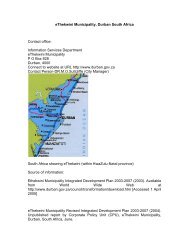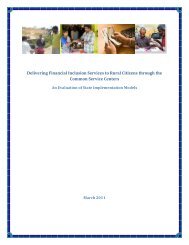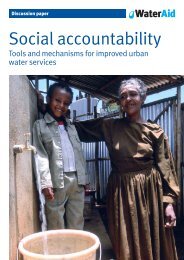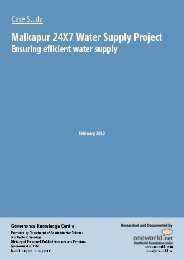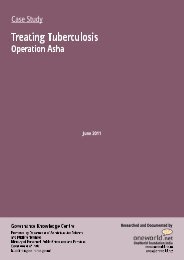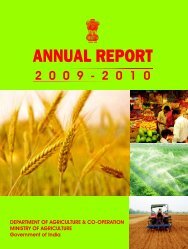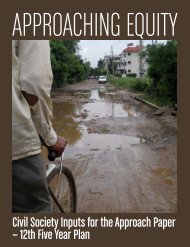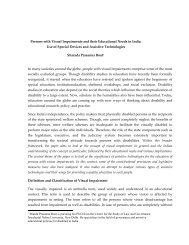Changing Framework of Local Governance and - Create
Changing Framework of Local Governance and - Create
Changing Framework of Local Governance and - Create
You also want an ePaper? Increase the reach of your titles
YUMPU automatically turns print PDFs into web optimized ePapers that Google loves.
<strong>Changing</strong> <strong>Framework</strong> <strong>of</strong> <strong>Local</strong> <strong>Governance</strong> <strong>and</strong>Community Participation in Elementary Education1. Introduction<strong>Governance</strong> reform has emerged as a key concept shaping all debates <strong>and</strong> discourses ondevelopment in recent years, significantly impacting the dynamics <strong>of</strong> policy making as well asthe implementation <strong>of</strong> development programmes. In particular, there is an increasing trend <strong>of</strong>moving decision-making processes away from authorities at the centre to organizational units<strong>and</strong> towards individuals operating nearer to the grassroots, changing the patterns <strong>and</strong>distribution <strong>of</strong> power <strong>and</strong> influence at different levels. These trends can be observedeverywhere – from liberal democracies to totalitarian regimes, unitary central governments t<strong>of</strong>ederal arrangements, developing economies, <strong>and</strong> countries in transition to industrializedcountries. Changes in educational governance which are currently engaging the minds <strong>of</strong>planners <strong>and</strong> policy makers should be viewed as part <strong>of</strong> this larger phenomenon <strong>of</strong> reformingpublic governance structures <strong>and</strong> processes. Decentralisation, in particular, is beingrecommended as an important means <strong>of</strong> promoting progress in mass education <strong>and</strong> the Dakar<strong>Framework</strong> <strong>of</strong> Action (UNESCO, 2000) explicitly calls for developing responsive,participatory <strong>and</strong> accountable systems <strong>of</strong> educational governance <strong>and</strong> management:The experience <strong>of</strong> the past decade has underscored the need for better governance <strong>of</strong>education systems in terms <strong>of</strong> efficiency, accountability, transparency <strong>and</strong> flexibility sothat they can respond more effectively to the diverse <strong>and</strong> continuously changing needs<strong>of</strong> learners. Reform <strong>of</strong> educational management is urgently needed — to move fromhighly centralized, st<strong>and</strong>ardized <strong>and</strong> comm<strong>and</strong>-driven forms <strong>of</strong> management to moredecentralized <strong>and</strong> participatory decision-making, implementation <strong>and</strong> monitoring atlower levels <strong>of</strong> accountability. These processes must be buttressed by a managementinformation system that benefits from both new technologies <strong>and</strong> communityparticipation to produce timely, relevant <strong>and</strong> accurate information (UNESCO,2000:19).Establishing grassroots level democratic institutions for local self-governance has been anintegral part <strong>of</strong> the Indian perspective on public administration for some time. Efforts in thisdirection began even before gaining independence from British colonial control more than 60years ago. The Constitution <strong>of</strong> the country adopted in 1950 made this explicit by directing allstates to create local self-government bodies under the framework <strong>of</strong> panchayati raj 1 throughan electoral process. Article 40 <strong>of</strong> the Constitution <strong>of</strong> India states that ‘the State shall takesteps to organize village panchayats <strong>and</strong> endow them with such powers <strong>and</strong> authority as maybe necessary to enable them to function as units <strong>of</strong> self-government’. Subsequently, theBalwant Rai Mehta Committee recommended the establishment <strong>of</strong> the panchayati raj systemas an inter-connected three-tier organizational structure <strong>of</strong> democratic decentralization at thevillage, block <strong>and</strong> district levels.1 Village panchayat is the lowest level <strong>of</strong> democratically elected self-governing body operating in every villagewithin the three tier system <strong>of</strong> panchayati raj. Panchayati Raj is a system <strong>of</strong> governance inwhich gram panchayats are the basic units <strong>of</strong> administration. It has 3 levels: village, block <strong>and</strong> district. At thevillage level, it is called a panchayat. It is a local body working for the good <strong>of</strong> the village. The number <strong>of</strong>members usually ranges from 7 to 31; occasionally, groups are larger, but they never have fewer than 7members.1




